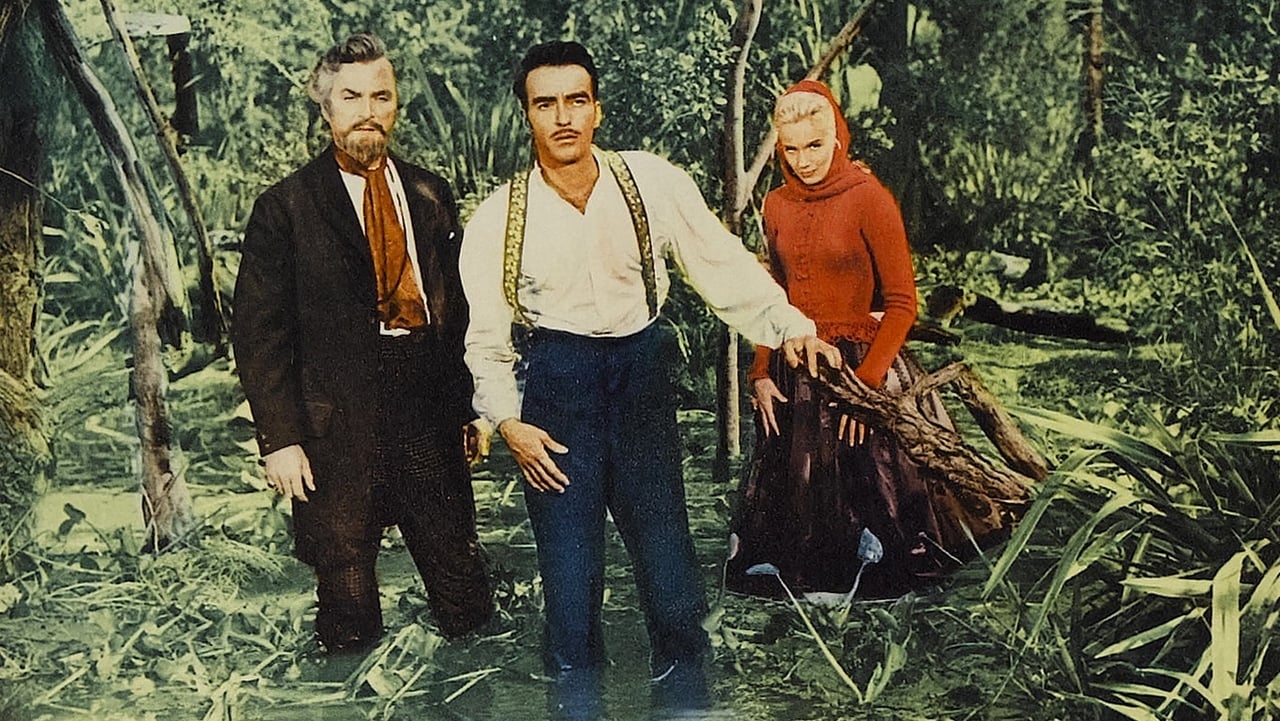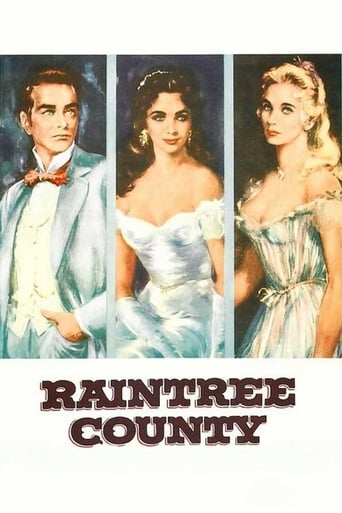

Considering the cast and that it is thought as having similarities with Gone With the Wind, Raintree County really did have potential to be a great film. Unfortunately, while it is as bad as some have said it to be it was one of those films with undeniably great things but missed the mark. Raintree County is a wonderful-looking film, the photography has that epic sweep and the costumes and sets are sumptuous and colourful(just look at Elizabeth Taylor's gowns here). Johnny Green's score is hauntingly beautiful with a discordant quality in the darker parts(like the scene in the burnt-out mansion) and a welcome degree of orchestral schmaltz in the strings without over-powering in any way. The song sung by Nat King Cole is highly emotive and Cole gives it even more of an emotional quality. Elizabeth Taylor really does smoulder here and gives some of her finest screen work, giving a very unsympathetic character a good amount of colour. The supporting cast fare well too mostly, Lee Marvin and Neil Patrick especially who look as though they're thoroughly enjoying themselves and steal every scene they feature in. Rod Taylor is fine too. However, Montgomery Clift is too wooden and stoic and spends about half the film looking on edge, understandably admittedly though due to his near-death experience. Eva Marie Saint had a very underwritten character and poor dialogue to work with but she doesn't succeed in bringing charm or colour to the role and instead comes across as bland and annoying. Agnes Moorhead is quite good but has very little to do considering her calibre. Raintree County is one of those films where it's beautiful and glossy on the surface but under it it's underwhelming. The script is rather leaden in flow with some very clumsy dialogue(especially Saint's and some of Taylor's, the more insane Taylor gets the more uncomfortably over-heated the film gets too). Few of the characters are interesting, Susanna is a colourful character but Nell is both grating and underwritten(like the other woman from hell but in an over-familiar way) and Johnny is even blander and too overly-idealistic, almost at times too perfect as well. The story could have done a much better job with the complex, ahead-of-its-time issues and themes- with better dialogue and characterisation-(Giant also had even more daring issues and themes and incorporated them much more compellingly) and crawls limply along with a particularly long-winded and dramatically passionless first 45 minutes and a lot of overlong padding throughout the film, making the already long length seem longer. This viewer does not have a problem with long lengths or slow pacing, films and TV series have worked with both, but it is highly dependent on how the quality of the writing is which was for me and a lot of others where Raintree County fell short. The direction is rich in spectacle but with not much enthusiasm elsewhere. In conclusion, wonderful-looking but dull, a case of (no meanness intended) the off-screen drama- Clift's car accident/near death experience- being more absorbing than the film itself. The masterpiece that is Gone With the Wind(as this has been compared to) Raintree County is not. 5/10 Bethany Cox
... View MoreThe story opens in 1859, in rural Indiana, as John and Nell (Montgomery Clift, Eva Marie Saint) are graduating from school. Though they've been in love for years, John is bewitched by the beautiful newcomer, Susanna (Elizabeth Taylor), a high-strung and unstable young woman.This 1957 film is an obvious attempt to match the grandeur of "Gone With the Wind" and it fails miserably. It's poorly written; by trying to include battle scenes, romance, mental illness, slavery, and good ol' country life, it lacks focus and purpose. Taylor shrieks and wails in her faux-Southern drawl and generally overacts the whole time, although she does wear some spectacular gowns. Saint and Clift are a boring couple and I didn't care about them at all. Rod Taylor and Lee Marvin steal the show - what there is of it - with bravura performances. Bad movie.
... View MoreI feel really guilty because my partner of 40 years, who is an avid film collector, fished this tape out of his vast repository (5000 films) and set it up so I could watch it. Since his media center is in one room and our eating space in another (the kitchen)I was running back and forth between the movie and my breakfast lasagne waiting breathlessly for La Liz's entrance which I caught just in time between bites of food and of course she was ravishing as always and utterly the center of attention in every shot, everyone else fading into the woodwork - there will never be a star to equal her! But alas the script is a muddled mess and there is no question the studio (MGM)could not have found a worse writer than they did - I looked him up here and he did nothing to warrant being asked to adapt Raintree County from the book which he did along with the book's author. Right off the bat both the story and the central character (The Professor) are just plain silly with heartthrob Clift running off into a swamp in his Sunday Best for absolutely no reason and the professor running off with some man's wife. What all this has to do with the main storyline is anyone's guess, but after reading the synopsis of the story here I realized that poor MGM in its quest to film a sequel to GWTW failed miserably with this pathetic attempt. As the old saying says, you can't go home again!
... View MoreI wasn't quite of age when this film was made and came out. I only saw it on television many, many years later. Its contemporary blockbuster "Ben-Hur", however (filmed in the same insanely spectacular Camera 65 process), did make it across the border to Canada and became compulsory viewing for all good little Catholic boys in my native Quebec. As this latter film was a remake of a past MGM glory, so was "Raintree County" supposed to rival "Gone With the Wind" in splendour and publicity. Although this hooplah never made it across the border into Canada either, I suppose it did have an effect on the American Public in those pre-video days when the chance of seeing GWTW again in all its Technicolor glory seemed slim to none. If you happened to be American and a little older than myself and a teenager in 1957, you would have known that Elizabeth Taylor was the flesh-blood-and-celluloid embodiment of the Veronica character in the Archie comics and the most desirable teen idol who ever graced a magazine cover. A rumoured romance with Montgomery Clift and her recent widowhood didn't hinder her status as queen of the teen tabloids. As a three hour period "Peyton Place"-like melodrama, the film was sure to be a hit with romantic US adolescents of both sexes and I think it is remembered fondly for that reason, despite its commercial flop. Its theme of miscegenation made it contemporary in a kind of daring pre-Civil Right Movement way and its unromantic, if not downright cynical view of the war made it a "serious" film. The thing that struck me the most about the reputation of that film is that when I became an avid collector of soundtracks on vinyl in the 80's I found out - to my utter befuddlement - that in collectors' cicles its legendary double stereo LP OST album of a very atypical score (by Johnny Green) was the most sought-after item in the history of the medium. (It is now finally available on CD, although, amazingly, the film itself is still not on Region 1 DVD.) In those days before video became the force that it is in making movies known and available to the largest audience, soundtrack albums were the best (and sometimes only) way fans could actually connect with the magic of reliving experiences tied to a beloved film that one didn't expect to ever see again except in souvenir-program format. And the fact that a relatively "un-Golden era" but perfectly original and competent composer like Johnny Green could attract that kind of attention is an apt measure of the love and fond remembrances that a lot of early baby-boomers felt for this movie, despite all its other faults and qualities.P.S.: The well-known factoid that the novelist's name was misspelled in the opening credits of the film is indicative of two things: (1) that the literay origins of the film didn't count for much in the attendant hype surrounding its production and (2) that big studios like MGM were starting to creak at the seams and to overextend themselves with such gigantic projects that couldn't possibly be held together in a rational manner. Distant echos of the future "Cleopatra" fiasco...
... View More